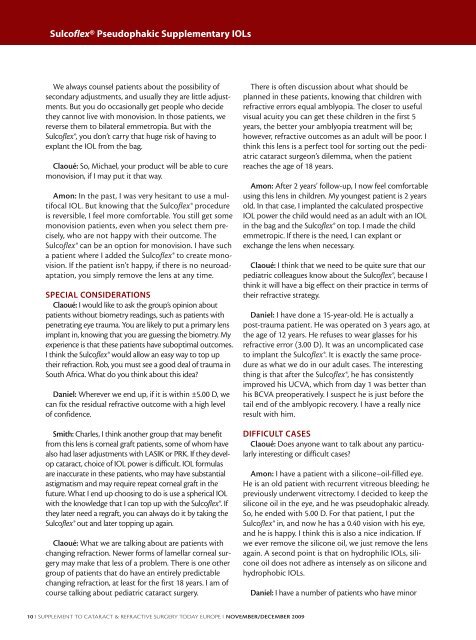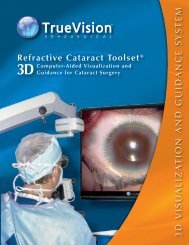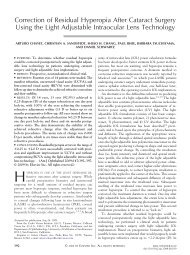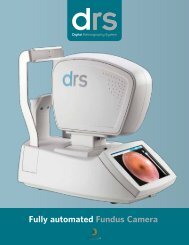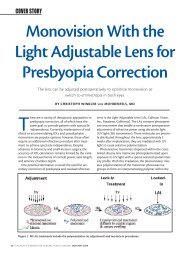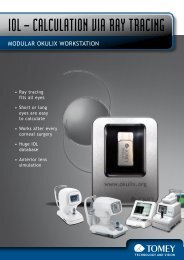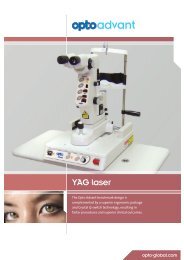Sulcoflex ®Pseudophakic Supplementary IOLs - Iogen
Sulcoflex ®Pseudophakic Supplementary IOLs - Iogen
Sulcoflex ®Pseudophakic Supplementary IOLs - Iogen
Create successful ePaper yourself
Turn your PDF publications into a flip-book with our unique Google optimized e-Paper software.
<strong>Sulcoflex</strong>® Pseudophakic <strong>Supplementary</strong> <strong>IOLs</strong><br />
We always counsel patients about the possibility of<br />
secondary adjustments, and usually they are little adjustments.<br />
But you do occasionally get people who decide<br />
they cannot live with monovision. In those patients, we<br />
reverse them to bilateral emmetropia. But with the<br />
<strong>Sulcoflex</strong>®, you don’t carry that huge risk of having to<br />
explant the IOL from the bag.<br />
Claoué: So, Michael, your product will be able to cure<br />
monovision, if I may put it that way.<br />
Amon: In the past, I was very hesitant to use a multifocal<br />
IOL. But knowing that the <strong>Sulcoflex</strong>® procedure<br />
is reversible, I feel more comfortable. You still get some<br />
monovision patients, even when you select them precisely,<br />
who are not happy with their outcome. The<br />
<strong>Sulcoflex</strong>® can be an option for monovision. I have such<br />
a patient where I added the <strong>Sulcoflex</strong>® to create monovision.<br />
If the patient isn’t happy, if there is no neuroadaptation,<br />
you simply remove the lens at any time.<br />
SPECIAL CONSIDERATIONS<br />
Claoué: I would like to ask the group’s opinion about<br />
patients without biometry readings, such as patients with<br />
penetrating eye trauma. You are likely to put a primary lens<br />
implant in, knowing that you are guessing the biometry. My<br />
experience is that these patients have suboptimal outcomes.<br />
I think the <strong>Sulcoflex</strong>® would allow an easy way to top up<br />
their refraction. Rob, you must see a good deal of trauma in<br />
South Africa. What do you think about this idea?<br />
Daniel: Wherever we end up, if it is within ±5.00 D, we<br />
can fix the residual refractive outcome with a high level<br />
of confidence.<br />
Smith: Charles, I think another group that may benefit<br />
from this lens is corneal graft patients, some of whom have<br />
also had laser adjustments with LASIK or PRK. If they develop<br />
cataract, choice of IOL power is difficult. IOL formulas<br />
are inaccurate in these patients, who may have substantial<br />
astigmatism and may require repeat corneal graft in the<br />
future. What I end up choosing to do is use a spherical IOL<br />
with the knowledge that I can top up with the <strong>Sulcoflex</strong>®. If<br />
they later need a regraft, you can always do it by taking the<br />
<strong>Sulcoflex</strong>® out and later topping up again.<br />
Claoué: What we are talking about are patients with<br />
changing refraction. Newer forms of lamellar corneal surgery<br />
may make that less of a problem. There is one other<br />
group of patients that do have an entirely predictable<br />
changing refraction, at least for the first 18 years. I am of<br />
course talking about pediatric cataract surgery.<br />
10 I SUPPLEMENT TO CATARACT & REFRACTIVE SURGERY TODAY EUROPE I NOVEMBER/DECEMBER 2009<br />
There is often discussion about what should be<br />
planned in these patients, knowing that children with<br />
refractive errors equal amblyopia. The closer to useful<br />
visual acuity you can get these children in the first 5<br />
years, the better your amblyopia treatment will be;<br />
however, refractive outcomes as an adult will be poor. I<br />
think this lens is a perfect tool for sorting out the pediatric<br />
cataract surgeon’s dilemma, when the patient<br />
reaches the age of 18 years.<br />
Amon: After 2 years’ follow-up, I now feel comfortable<br />
using this lens in children. My youngest patient is 2 years<br />
old. In that case, I implanted the calculated prospective<br />
IOL power the child would need as an adult with an IOL<br />
in the bag and the <strong>Sulcoflex</strong>® on top. I made the child<br />
emmetropic. If there is the need, I can explant or<br />
exchange the lens when necessary.<br />
Claoué: I think that we need to be quite sure that our<br />
pediatric colleagues know about the <strong>Sulcoflex</strong>®, because I<br />
think it will have a big effect on their practice in terms of<br />
their refractive strategy.<br />
Daniel: I have done a 15-year-old. He is actually a<br />
post-trauma patient. He was operated on 3 years ago, at<br />
the age of 12 years. He refuses to wear glasses for his<br />
refractive error (3.00 D). It was an uncomplicated case<br />
to implant the <strong>Sulcoflex</strong>®. It is exactly the same procedure<br />
as what we do in our adult cases. The interesting<br />
thing is that after the <strong>Sulcoflex</strong>®, he has consistently<br />
improved his UCVA, which from day 1 was better than<br />
his BCVA preoperatively. I suspect he is just before the<br />
tail end of the amblyopic recovery. I have a really nice<br />
result with him.<br />
DIFFICULT CASES<br />
Claoué: Does anyone want to talk about any particularly<br />
interesting or difficult cases?<br />
Amon: I have a patient with a silicone–oil-filled eye.<br />
He is an old patient with recurrent vitreous bleeding; he<br />
previously underwent vitrectomy. I decided to keep the<br />
silicone oil in the eye, and he was pseudophakic already.<br />
So, he ended with 5.00 D. For that patient, I put the<br />
<strong>Sulcoflex</strong>® in, and now he has a 0.40 vision with his eye,<br />
and he is happy. I think this is also a nice indication. If<br />
we ever remove the silicone oil, we just remove the lens<br />
again. A second point is that on hydrophilic <strong>IOLs</strong>, silicone<br />
oil does not adhere as intensely as on silicone and<br />
hydrophobic <strong>IOLs</strong>.<br />
Daniel: I have a number of patients who have minor


